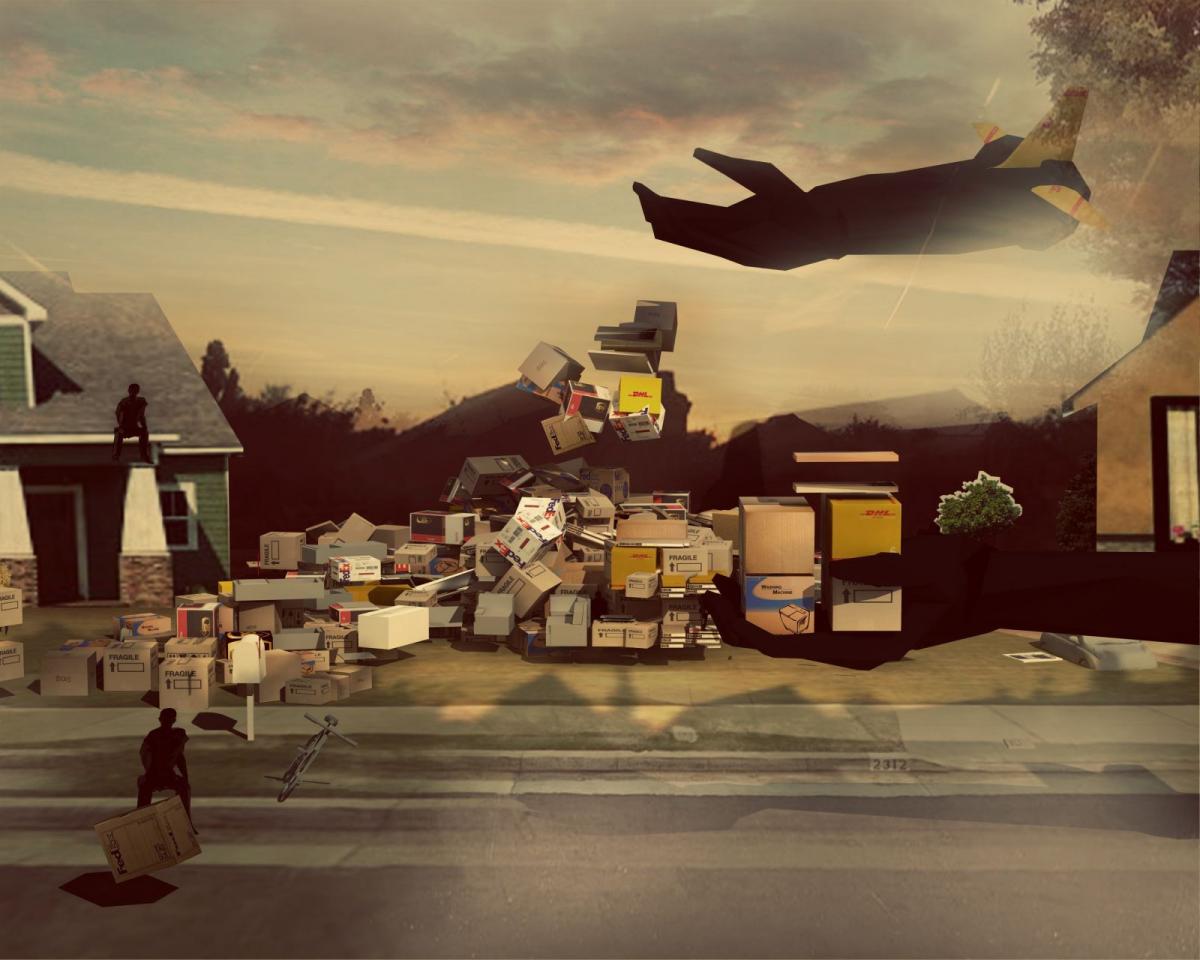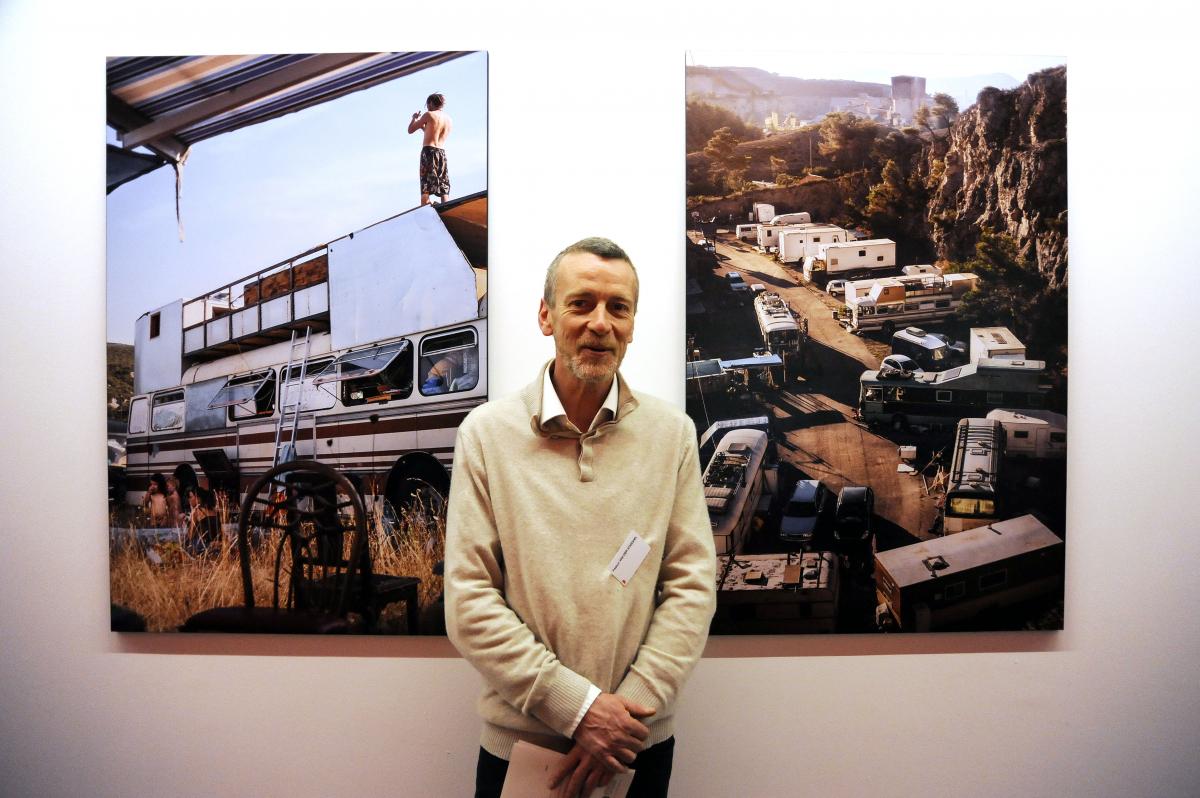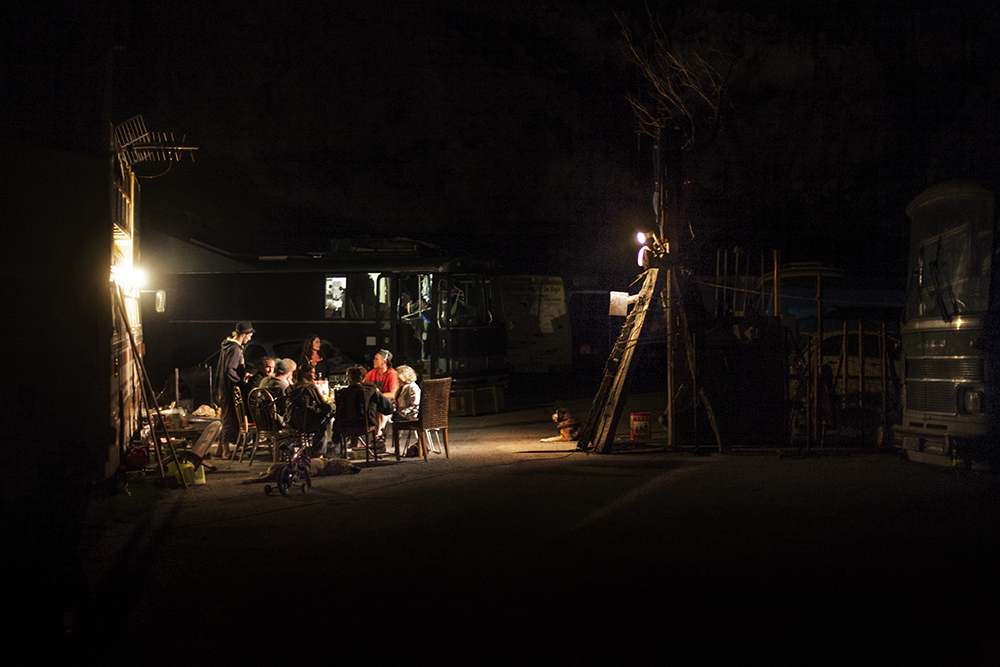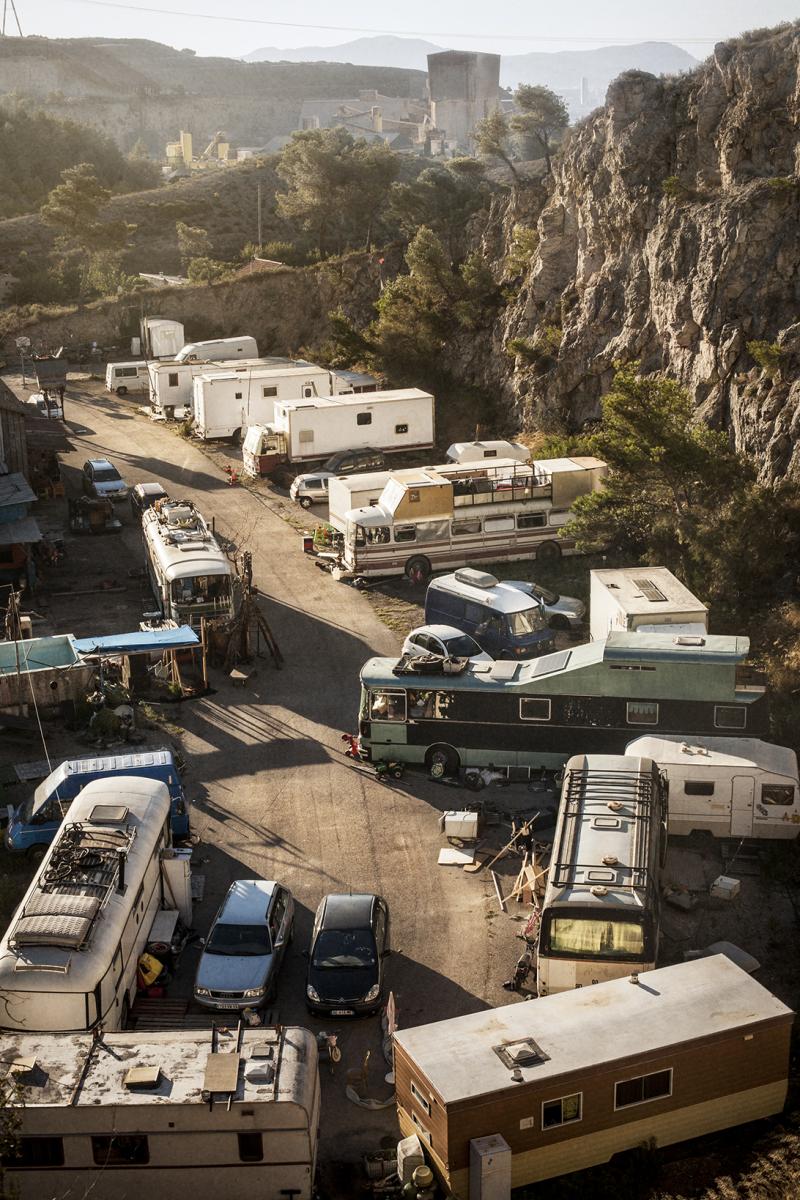
April 2013
Impressions on the artworks displayed during the International Meetings of the Mobile Lives Forum.
*
January 24-25. Conference and exhibition ( Vertigo and myths of the peri-u r ban ). Maison Rouge, Paris.
A hundred or so participants. Analyses , controversies, proposals to do lab work , to imagine – differently . Nine artists brought together in the exhibition spaces, extending the debates to the walls , o pening novel fields of analysis , venturing that which scientific discourse cannot perhaps (digression, personal viewpoint , exploration of new languages , etc.). The approach is experimental. To open horizons, with the belief that a broader vision of the topic can emerge .
The voices of experts on peri-urbanity accompany us on our visit. We try to start a dialogue .
A conversation with Dutch artist Justin Bennett. A little further on , a room dedicated to him – a darkroom. Edgeland , 2013. The dark is for the image : a new slide every ten, fifteen minutes. Outskirts of cities. ( Periurbanities, plural ). And especially t he dark – as a space cleared out for better sound. Bennett installed a multidirectional microphone at each of the peri-urban sites he visited . H e told me “on the outskirts of Amsterdam and other cities in the Netherlands .”
The fixity of the image, less to be looked at than to channel the gaze. Neutral ground where one can dissect what one hears . Bennett works in the formless – the formless sound of peri-urbanity . Not architecture , but vanishing lines . I try to compare this approach with symposium debates that revolve around the essence of the peri-urbanity , going so far as to challenge the merits of the term. Here, peri-urbanity is not a given, built place , but rather an area of outlines. That alone defines it : an interlacing of currents, flows . F lows mixed with nature - wind, crickets, echoes - brought by the movement of people . Vanishing lines (I emphasize) .
I picture this space; whether considered inside or outside the city, it is above all this energy of lines that holds my attention. A place that is not confined but rather a network space - a space of flow. Not a geography of borders, but a cybernetic geography, a space of power lines.
These bundles of lines that seem to want to define the peri-urban space remind me of Professor Heinz Wismann’s theories regarding perspective in painting . P recisely because of these vanishing lines that resolve themselves in the picture , in the vanishing point. It is the invention of the Renaissance. Alberti, De Pictura , 1435. The invention of the unique perspective. The perspective is now that of the subject , who takes power, who determines the purpose ( the famous point) around which the painting is organized.
And what is the purpose of all the lines? Heinz Wismann says: utopia. The goal of painting is this. Utopia. Think of Thomas More, a few years after Alberti. He created the term utopia. These inventions are related , of course. Utopia . Forged from the Greek ou "non" and topos "place" : the non- place . Non-place, like Justin Bennett ’s still images revealing the essence of a peri-urban area that is not physical , not geographically situated, but in flux , in the pulse of a fundamental flux, an invisible going towards . The place has no identity of place - albeit geographical - but a dynamic identity .
I listen to the lines of sounds, their vanishing. To where? What non-place ? Will these peri-urban areas be places first and foremost (no, we said they weren’t), rather dynamics of utopia? Utopia of the subject who has returned to power — the subject of the Renaissance, he who has set the goal. One thinks, of course, of the great political and marketing programs which drove this boom of suburban areas. What aspiration do they reflect ?
It appears that this central notion runs through both the works and the discussions – that of an unreachable Nature around which everything seems to condense. And first the paradoxes: the ways for strengthening ties with it also draws boundaries. Nature is striated with cuts in both the images of Justin Bennett and in the soundtrack and images Arianne Michel’s video ( Autotrophie , 2013).
The sounds speak desire – desire to the brink of the unbearable, of the quest for nature. They express a hypertrophic ideal to the point of denying it. The ideal of harmony turned to constraining sound. Deafening.
While society underwent this same movement as during the Renaissance (the taking of power by the subject, utopia), is it not, in fact, the Antique model that it craves with this thirst for nature? In the writings of Hölderlin, the Greek Hyperion tells us “I will have seen it once - that one thing my soul sought and the perfection that we place beyond the stars, that we push to the end of time, I felt it present. The supreme good was there, in the circle of things and human nature.” 1 The Greeks have nature at their disposal all around them. They carve up parcels ( templum ) of this cosmos (which signifies harmony) in order to read them.
Quest to have nature within easy reach, from which to draw harmony lost. Is it not such an aim that set “rurbanites” in Nicolas Boone’s film La Transhumance Fantastique (2006) on the tracks of an old railroad (the tracks of an antique, imagined past?). A collective illusion inferred by the mimed tennis match scene in Michelangelo Antonioni film Blow Up (1967); nature at this point so removed from man that he can only get lost in it. And the modern western, departing from allusions to the conquest of the West (here, Nature) to become a parody of George Romero’s Night of the Living Dead (1968) or Tobe Hooper’s Texas Chainsaw Massacre (1974). The pessimism that shows men incapable of shaking the progressive, consumerist model that prevails even to the furthest reaches of the countryside and causes them to fall into destructive madness is chilling. One sees here the artist’s uncompromising critique of the pitfalls of the slogans that accompanied the peri-urban ideal, and how the more man tried to get closer to nature, the more he denied it. This is a pattern of interferences that was created, rather than one of harmony with it.
Domesticated Mountain , Andreas Angelidakis

Likewise a pessimist is Greek filmmaker Andreas Angelidakis [ Domesticated Mountain, 2012 ] , who also shows us peri-urbanity not as a fixed place, but as a drift – virtual drift in an interactive superstructure. "Suburbanity": to move in pathways of acts of purchase and delivery of goods. Peri-urbanity is located not in physical geography, but marketing. Dynamic territory there again, but that has finished consuming its utopia of nature through the use of the psychotropics of unbridled consumerism, which have replaced the vanishing point. Now, vanishing in the frames, mathematic determinants of lifestyle, absolute algorithmic determinants of society. This world that no longer has a center, the artist tells us, is the world of internet "suburbanity" and its architecture that governs our existence and, by this same architecture, determines how it behaves. For him or her, the real peri-urbanity that raises questions is a virtual peri-urbanity – a space of transposition of a utopia sick with consumerism.
Of all these works, it appears that peri-urbanity is movement first and foremost - a dynamic both expressed and latent. And physical movement appears to be the outgrowth of a momentum that is, above all, existential - a fundamental thirst.
If physical geography is problematic (it encloses), Justin Bennett partially opens a trap door. Sound (and the sensitive more broadly) is a journey, a space of reappropriation. This is what the artist tells us by playing with frequencies and durations in his soundtracks. He moves freely and independently in that which moves. That’s the journey: moving in movement. Not being a spectator of the sensitive, but a co-creator of reality alongside him.
*
NoLand’s man project . Ferjeux Van der Stigghel, artist, Yves Pedrazzini, sociologist, Maude Reitz, anthropologist and Sophie Greiller, architect. Four gazes fixed on the study of neo-nomads. The artistic work as amplifier and explorer of this lifestyle and the esthetic of marginality. In its framework, discourses combine to renew understanding.
Encounter with the photographs of Ferjeux Van der Stigghel. Images of communities, of transhumance, of couples, workers, and more. Images that allow us to dwell on aspects of these lives that never stop.

Lives of nowhere. Or in other words everywhere. Living, but always outside the walls, off screen. Elusive. Plural populations. Leaving no traces. The imprint is that which marks. No mark. Dilemma: the work of art (exhibited) meets the unexhibitable. The dark in the photos, you must understand, is resistance to demonstration. Escaped, latent, always possible. To say that the essential image cannot fit in the traditional image - revelation is negation.
How to capture a flow without risking losing it? You must melt into it. Use the sole fixative that does not fix: poetry. Poetry that does not take hold but simply goes with . So the photographer goes with. The work is first and foremost the work of experience. Ferjeux Van der Stigghel bought and converted his own truck. He followed caravans along the highways as well as lone walkers on back roads.
His photographs start well before the image we see - in the going with . The work is above all his own act, his own poetic habitation. What we see is a time, a second, and hour, a day, a life – of exposure. Itinerant photography, a path outside the framework – he is one of them.
I come back to the dark in his photos, or low light, I could say. Significant areas of measurement, without limits. I think of the paintings of Mark Rothko, of the infinite impregnation of space, of places without places, states of pure presence, of time and distances, infinite. I think of a mystique of space - immanence. Being on the road - not towards a somewhere, but towards the road itself. Being is to be in the journey - or in the possibility offered by the journey. And immobility - albeit for a decade – that likewise becomes the experience of absolute mobility.

Mobility, or having no ties, no land – or all lands. The roots of neo-nomads do not take in order to possess, but rather to dispossess themselves. Mobility in its essence touches the quest for a freedom constantly asserted. We can’t capture the wind, we feel it, and it is in feeling it that we possess it. In contrast with ambient consumerism, we enter into a space of the moment, of intensity, of presence in the world.
Moving is first and foremost knowing that we can move ; in the mouth, the taste of freedom that throws off the chains and gives the man back to himself – in his hands, the material available of his destiny.
Van der Ferjeux Stigghel does not yield to utopia. If he does the work of a poet, if he offers us passages, gives us horizon, he does not point less to the harshness of reality: insecurity, marginalization, misunderstanding, the clash (which we feel, in suspense, so often) with societal architecture unable to question itself, unable to depart from its schemata and think of itself using other codes. Yes, it is a work that disturbs, a work of uncomfortable wonder - a beauty that worries and fascinates.
1 Hölderlin, Hypérion , trad. Philippe Jaccottet, NRF Poésie/Gallimard, Paris, 1973, p.110

Autres publications